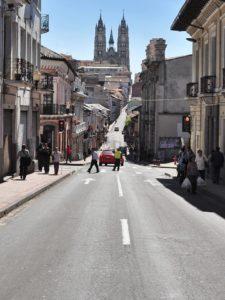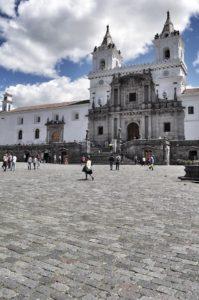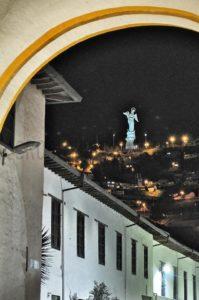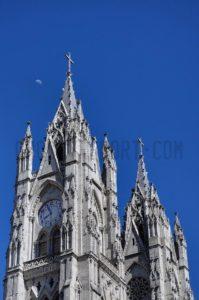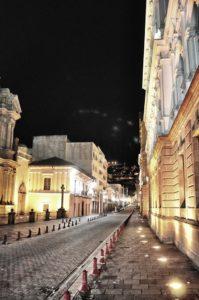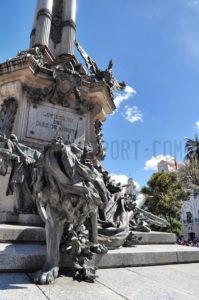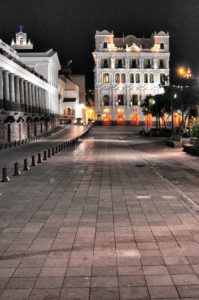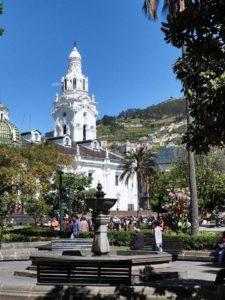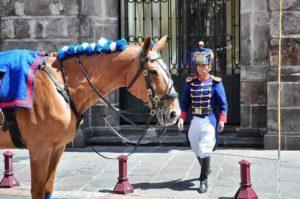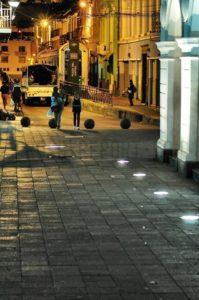Though Quito Ecuador was merely the country's second-highest capital city, and only the second capital of the Inca Empire, it still was, and still is, first in “cities surrounded on all sides by volcanoes.” Whoever built this incredible city in this dangerous location must have had a real gambling problem.
Quito Ecuador is, for now, located in the Andes Mountains.

The city of Quito's precarious position—between multiple lava-spewing earth-acne pimples—makes for spectacular city views (and a highly profitable insurance industry, no doubt). Yet we weren't there for the views, culture, or cuisine. Instead, we were there just to rest after seeing Machu Picchu, and kill time until flying to the Galápagos. Still, we looked around a bit.
As a comparable major city in the Southern Hemisphere, Quito seemed far more modern than Lima, Peru (though Lima's smog could've obscured hipster clothing stores and alternative coffee shops for all we know). Quito's dazzlingly bright sun and clean, fresh air really made the place sparkle.

Quito Ecuador is a city built on more faith than the Vatican.
The Ecuadorian capital city of San Francisco de Quito (or just “Quito” to its close friends) is located over 9,000 feet above sea level in the Andes Mountains. And, much like Cusco in Peru, the altitude takes a bit of getting used to.
But what makes this metropolis unique in South America—and everywhere else on the planet, for that matter—is that the city was built within a valley surrounded by — wait for it — six volcanoes, one of which is still “very much active” and last erupted as recently as 1999.
Yes, you read that correctly: A city with over 2 million residents was built between SIX volcanoes.
Living on an earthquake fault in San Francisco seems sane by comparison.
Clearly, South Americans are insane. A city surrounded by six active volcanoes is about as bright as a city surrounded by multiple earthquake fault lines. And nobody in North America would be stupid enough to do that (I mean other than San Francisco, Los Angeles, Seattle, New York, Memphis, Juno, etc).
Crazier still, Quito Ecuador is located one degree south of the freaking equator (hence the name Ecuador), making it the skin cancer capital of South America. Yet even though the sun shines down on you like Inti's blowtorch, the city's elevation and freezing air temperature mostly prevents spontaneous human combustion as long as you're wearing SPF.
Quito Ecuador was the first city to be named a UNESCO World Heritage Site in 1978 thanks to the pristine condition of its Historic Center.
Quito's Old Town is in remarkable condition for being so old.
What's now called “The Old Town” is one of the largest, least-altered and best-preserved historic centers in the Americas. Visiting that area of Quito is like stepping back in time. Specifically to the 1500s, when the Spanish Conquistadors invaded and forced the Incas to construct a new European-style city center directly over top the Inca city center that used to be there.
Not that the Incas themselves were a bunch of sweethearts — they weren't. The Incas used “peaceful assimilation” to build their empire in the Andean region, but when that approach didn't work, they had a Plan B.
The native Quitu tribe, who lived in Quito Ecuador before the Incas, got “assimilated” right into extinction. So, when Francisco Pizarro invaded the place, you could argue that the Incas had it coming to them.
Quito Ecuador never saw it coming.
By the 1500s, the Spanish had imperialism down to an art form. Still, Francisco Pizarro's soldiers must have thought they'd died and gone to heaven when they landed in South America.
Imagine finding a native populace whose warriors wore loin cloths and who's land veritably vomited gold and silver. It must have been like facing a horde of angry teddy bears. Armed with horses and rifles — weapons the Incas had never seen before — the Spanish only needed 400 soldiers and a few weeks to take over their entire empire.
Over a hundred years of Inca culture and civilization were wiped out in a matter of a few short years, all in the service of finding and extracting all of South America's gold.
Peru took the brunt of the invasion as, by the time Pizarro got up to Quito, the local Incas had had enough to time to move their gold over the Andes into the Amazon basin (where it's still believed to be hidden). Failing utterly in his quest, Pizarro died looking for El Dorado, or “The Golden City,” and it serves the prick right.
Pizarro wasn't just a greedy a-hole, he was also a hardcore Catholic.
Pizarro was, however, more successful in forcibly converting the Incas to Catholicism en masse. His approach was as simple and elegant as it was violent and destructive: If something seemed Incan, they had it destroyed and replaced with a cross, or seven.
On the main drag through town, there had to be seven Incan temples. How do I know? Because now there are seven churches there. The Spanish conquerors built or “renovated” so many temples, they named the street to make sure people got the idea: Calle de Siete Cruces, or Street of Seven Churches. It was a super subtle “FU” to the Incan religion. But the last laugh is ultimately on the Spanish.

The Incas used an architectural innovation that placed huge, carefully carved rocks as a foundation with progressively smaller flat-carved wall rocks as the structure rose in height. The net effect of this approach was that the foundation stones were nigh indestructible.
Hilariously, the Incas built their sandstone temples so durably that no matter how hard the Spanish tried, they couldn't tear them down. So after countless attempts, the Spanish finally gave up and just built on top of the Incan foundations, which still remain as a testament to the Incas.
Employment in Quito spiked thanks to Pizarro and friends.
The Spanish were “job creators” because the huge Catholic churches that desecrated the Incas own religion didn't build themselves. As victors, the Spanish made the Incas construct the new Catholic churches as well as create the interior artwork. The Spanish taught/forced numerous Incan artists to work in the approved current style of the European Renaissance.
This must have been a difficult transition for the Inca artists, since they'd never seen realistic paintings before (or any paintings, for that matter). The Incas typically made sculptures and functional pieces of art such as jewelry, vases, bowls and the like.
Yet it was this primitive Incan art that inspired Pizarro to invade Quito Ecuador in the first place — most of their art was covered with gold!
That gleaming yellow metal was more common in South America than malaria, so the Incas didn't value it as a precious commodity, only as religious decoration. No doubt we'd be equally surprised if aliens from space invaded Earth to steal all our chrome.
The Spanish valued gold as a reason to bash in Incan skulls.
Pizarro melted down and made off with every nugget he could find, but “allowed” the Incas to use gold leaf. Artistic mash-ups of the European style and Incan gold embellishments created garish monuments to Catholic Imperialism, forced culture change, and good old over-the-top excessiveness,
Not a single surface inside the churches in Old Town appear un-“bedazzled.” So while Quito is today bereft of gold, it's still rich in historical oppression.
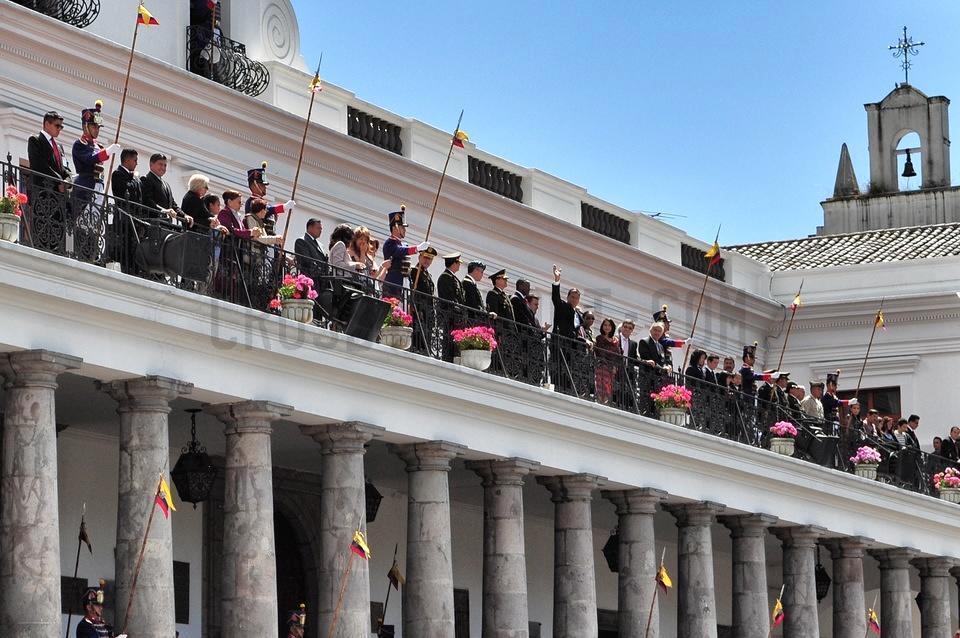
Outside the Old Town, Quito is a thriving, modern metropolis.
Possibly the reason Quito feels more modern than Lima or Cusco is because, in addition to tourism, Ecuador is the world's top exporter of yellow gold: That's right, bananas — almost a US$1B worth every year. No one produces more bananas than Ecuador.
Oh, and did I mention the black gold? Yeah, Ecuador produces around 500,000 barrels a day, making it the 30th largest oil producing country in the world (Peru is 44th with a measly 150,000bbls). That's enough oil to have a decent economy, but not enough to have Bentley-driving sheiks everywhere.
Now, you'd think Quito would be wealthy enough to keep the streetlights on past 6pm, but apparently not. Our hotel, the Quito Mercure, was located in a good part of the city (the financial district), we didn't explore the area much because the city was dark when we arrived—I mean, really dark. I'm talking “CSI:SVU intro scene” dark.
There was a comforting number of Policia around, but the lack of anyone else on the street weirded us out. What kids and tourists we did see walking around or hanging out appeared to be looking for something to do, too.
Food was available pretty much all over Quito Ecuador.
We did get to a couple of pretty good restaurants, including Theatrum above the Opera House. But since we didn't know where else to go or what to do in the New Town, we went back to the hotel bar, drank and watched subtitled Cinemax® movies.
Had we stayed longer, we no doubt would've gotten to experience more of Quito, but having covered off the touristy stuff, we didn't have the motivation to do much else. So we packed up our belongings and headed out to the airport for our flight to the Galápagos Islands ».

Click here to see more of Peter Crosby's photography, including pics from Quito, Ecuador.

